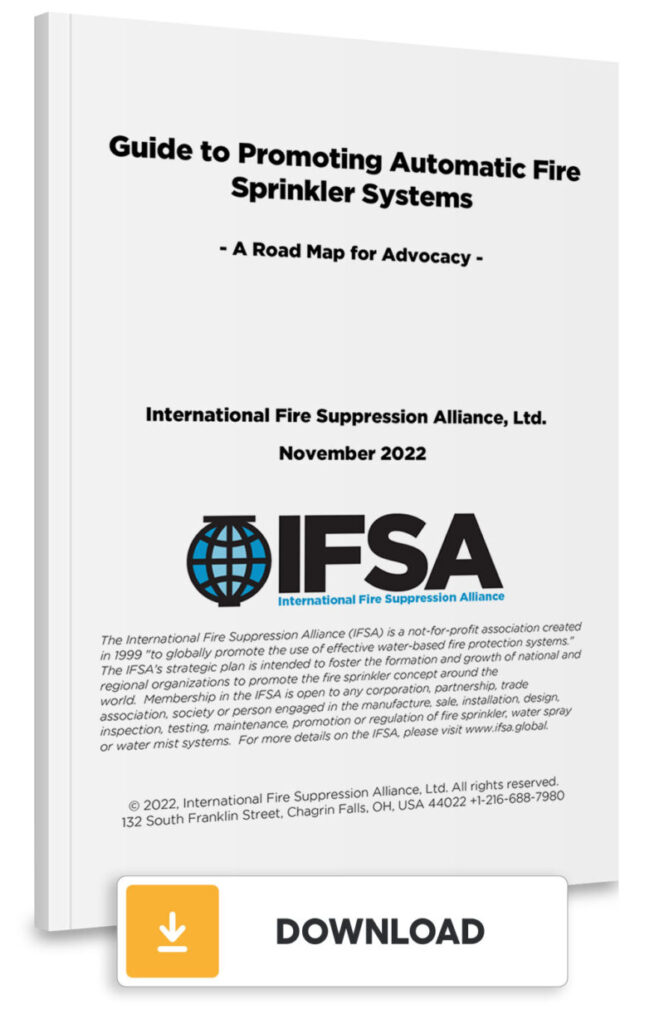Be a Fire Safety Advocate: Get the Guide to Promoting Automatic Fire Sprinkler Systems

Enter your email to download the full Guide.
In an ideal world, quality fire protection would be universally embraced, and voluntary installation of automatic fire sprinkler systems would be widespread.
That’s in an ideal world, where there aren’t real-world challenges. Economic constraints on building owners and code enforcement officials play a role in pushing fire protection measures lower on the priority list. There’s also the perception that fire incidents are rare and typically not severe, further reducing the urgency to invest in preventative fire suppression systems.
By not adequately protecting against fire, the safety risks are much greater for building occupants—including residents and workers, as well as for the general public and the firefighters who respond to emergencies.
Advocates of automatic fire sprinkler systems know their proven effectiveness in greatly reducing fire-related deaths, injuries, property damage, and related environmental or economic losses. They work to persuade government regulators to promote or mandate sprinkler installations through updated regulations. However, for these regulations to be effective, enforcement officials must have the necessary expertise to ensure compliance and verify the use of certified equipment.
That’s why, alongside regulatory improvements, there must be a focus on identifying responsible enforcement personnel, developing appropriate training materials, and implementing thorough training programs. This is key not only for proper system installation, but also for ensuring effective ongoing system inspection, testing and maintenance.
Developing a Reference Guide for Advocates
To help meet these challenges head on, the International Fire Suppression Alliance (IFSA) developed a guide that could be used as a reference by advocates to advance the use of fire sprinkler systems around the world. The goal was to create a document to describe the multiple ways organizations globally have been successful in increasing the use of automatic fire sprinkler systems. The guide would act as a “road map” so readers could learn from the experiences of others, highlighting efforts that proved to be successful and might be applicable in their part of the world, while also recognizing that not all countries and regions are alike.
As part of the development process for the guide, the IFSA surveyed 12 international fire sprinkler advocates about their experience. These advocates constituted an informal advisory group. We asked them to rank 10 common strategies aimed at increasing the use of automatic fire sprinkler systems. The ranking system ranged from 10.0 (most effective) to 1.0 (least effective), based on collective perceptions of each strategy’s potential impact.
What are the Best Ways to Promote the Use of Fire Sprinklers?
The 10 methods they identified in order of perceived effectiveness were:
- 7.3 Convincing code writers to require sprinkler systems for specific occupancies
- 7.0 Encouraging fire authorities to promote fire sprinklers
- 6.9 Creating economic incentives in building codes for sprinkler systems
- 6.5 Proposing legislation to enact fire sprinkler requirements
- 5.5 Advancing installation standards that lower sprinkler installation costs
- 5.1 Encouraging property insurance discounts for sprinklers
- 4.7 Informing public opinion as to the effectiveness of fire sprinklers
- 4.2 Promoting tax incentives for property owners to install sprinklers
- 4.0 Urging recognition for fire protection engineering
- 3.8 Educating the public as to how fire sprinkler systems work
The perceived effectiveness of various strategies to promote fire sprinkler use differs significantly, with notable variations influenced by the advocates’ geographic locations. Strategies that are effective in countries with strong building regulations may not be suitable in regions lacking such frameworks.
With the insight gained from this informal advisory group and leaning on the expertise of the IFSA and its members, we launched the guide in 2022—formally titled Guide to Promoting Automatic Fire Sprinkler Systems: A Road Map for Advocacy.
The Guide is filled with practical information to serve water-based fire suppression system advocates with a body of historical context, evidence of successful strategies and lessons learned that can be used and applied to their efforts. It is divided into 13 chapters, with the first one focusing on the 10 methods ranked above.
To address the differences noted above, the Guide outlines multiple advocacy strategies, explaining the conditions where each may be more or less effective. It serves as a flexible “roadmap” toward increasing fire sprinkler adoption, emphasizing that the first crucial foundational step is forming a dedicated advocacy group to lead and coordinate these efforts—which is the focus of chapter 2, “Forming an Advocacy Group.”
